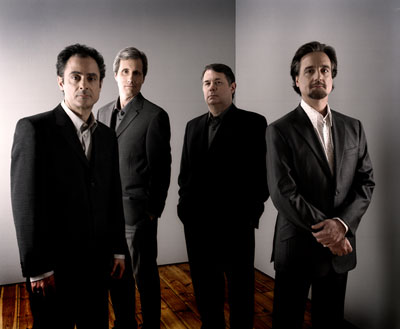Classical Music Review: Emerson String Quartet
By Caldwell Titcomb

Emerson String Quartet: Aside from the cellist, the musicians play standing up.
Courtesy of the Celebrity Series, the Emerson String Quartet, founded in our country’s bicentennial year of 1976, was in town for a Jordan Hall concert on December 4. Since the founding cellist and viola player served only briefly, the current members – Eugene Drucker and Philip Setzer, violins; Lawrence Dutton, viola; David Finckel, cello – have been playing together for thirty years (in contrast to the Juilliard Quartet, which has just acquired a new first violinist).
Two special things need to be said about these Emersonians. Except for the cellist, the musicians play standing up. And there is no permanent first violinist; depending on the pieces being played, Drucker and Setzer alternate as first and second violinists. On this four-work program, Drucker took the first-violin parts in the opening pair of pieces and the second-violin parts after intermission. This is an eminently fair practice, though not followed by most other ensembles.
The first offering was Charles Ives’ First String Quartet (1896), subtitled “From the Salvation Army,” composed during his four years of study at Yale. Ives frequently based his music on well-known melodies, and this piece is no exception. The opening Chorale, in C major, is a rather academic fugue written for his composition teacher, Horatio Parker. Its theme is the popular hymn “From Greenland’s Icy Mountains,” whose tune came from the pen of Lowell Mason, who spent many years in various musical posts in Boston.
The ensuing fast Prelude (G major), slow Offertory (D major), and fast Postlude (G major) all demonstrate Ives’ fondness for unorthodox, even awkward harmony and dissonance – admired by many and deplored by others (including me). The players dispatched the work with committed precision.
Another First Quartet followed, this one by the illustrious Czech composer Leoš Janáček (1854-1928). Written in 1923-24, it was the product of his maturity. He too used unorthodox harmony, but, unlike Ives, he knew what he was doing and the result is consistently convincing. The subtitle is “The Kreutzer Sonata,” ultimately a reference to Beethoven’s Op. 47 violin sonata. But it was picked up as the title of an 1889 novella by Tolstoy dealing with jealousy, adultery, and murder. The quartet is programmatic, and one can find in its four movements a tale borrowed from Tolstoy with a somewhat different outcome.
The first movement tosses motives from instrument to instrument. The second gives special prominence to the viola. The third makes use of the device known as “sul ponticello,” whereby the bow is to play at the bridge, producing a thin and glassy sound. The fourth brings us to a very soft and moving conclusion. The players really dug into this work and achieved a gutsy result.
After intermission the foursome played the celebrated Adagio by Samuel Barber, the slow movement of Op. 11, his only string quartet (1936). We usually hear it in an arrangement for full string orchestra, played to memorialize a death. Many people have no idea that the seven-minute piece was originally composed for only four players.
Shostakovich wrote 15 symphonies and 15 string quartets. In both categories his achievement was wildly uneven. The Emersonians selected Quartet No. 9 in E-flat (1964) as the program’s closer (they have recorded all fifteen). The piece is not one of the composer’s best, but it was good to hear it expertly played by a group deeply committed to it. It contains a lot of the galloping dactylic rhythms on which Shostakovich relied excessively throughout his career.
This is a big piece, more than a half hour long. It has five movements, which the composer indicated are to be played without break. A sonatina form (sonata-form without a development section) leads to two adagios separated by a central scherzo. At bar 235 of the scherzo a viola string broke. So there was an unplanned break while Dutton scurried offstage to install a new string and returned shortly. The players backed up a bit and sailed through the rest of the work without mishap. The finale, at 719 bars more than twice as long as any of the preceding movements, has a lengthy fugue in the middle before homophonic texture leads to an ending that is furious, even ferocious.
A huge ovation brought the players back for a short encore, an arrangement of a sweet Dvořák song.

The review is so clear and precise; one feels as if one was there! The only comment I have to make is that there is a string quartet in France, Quatuor Diotima, whcere the violinists change places as do the Emersons. One of the violinists, Naaman Sluchin, studied for a while at Juillard, so maybe that idea came from there!